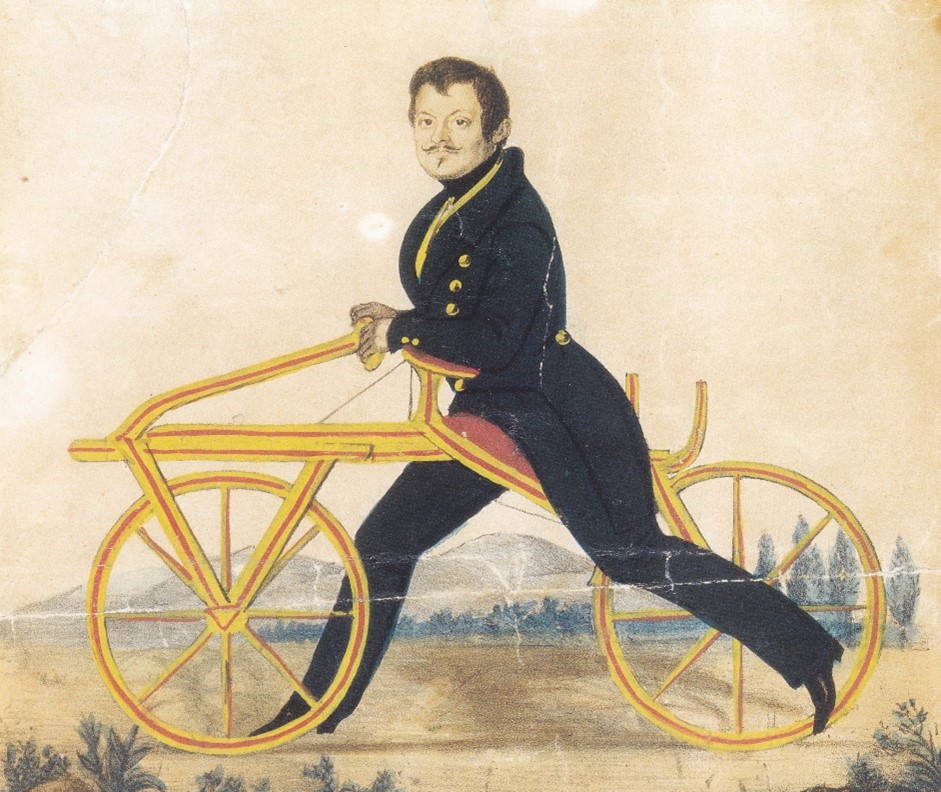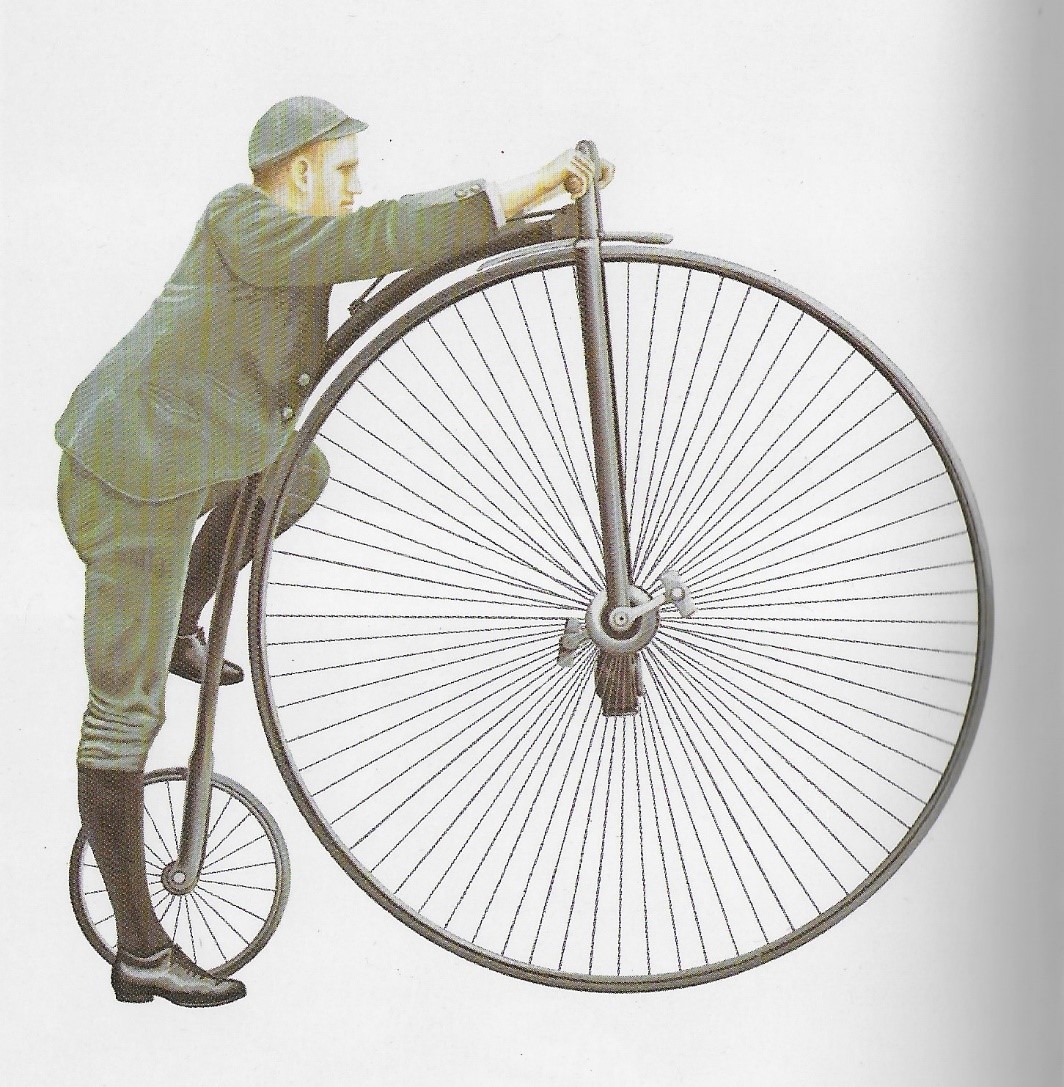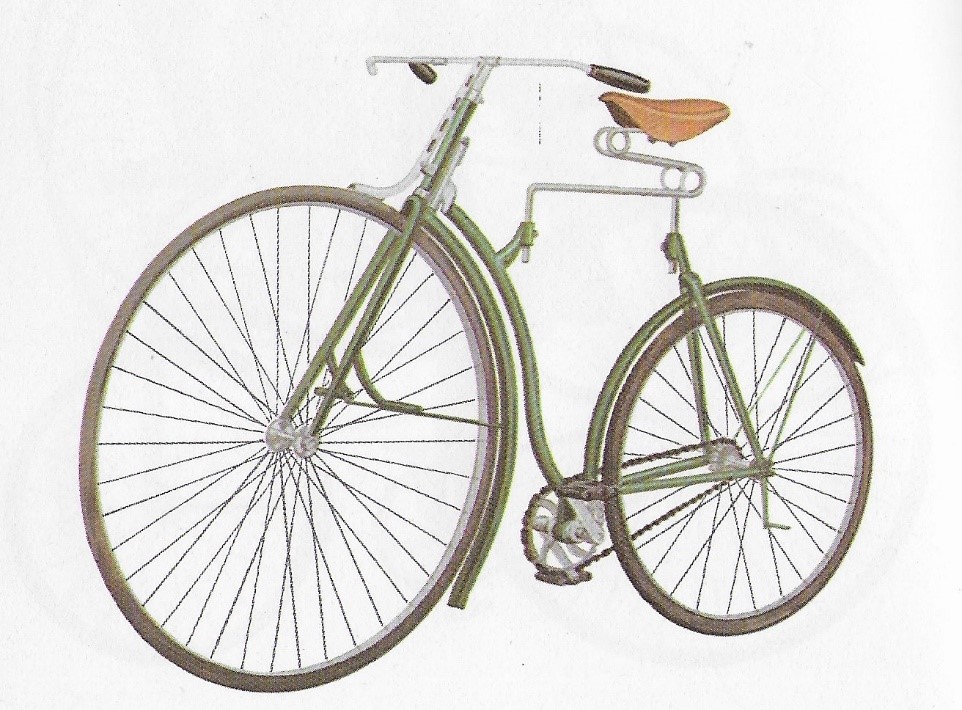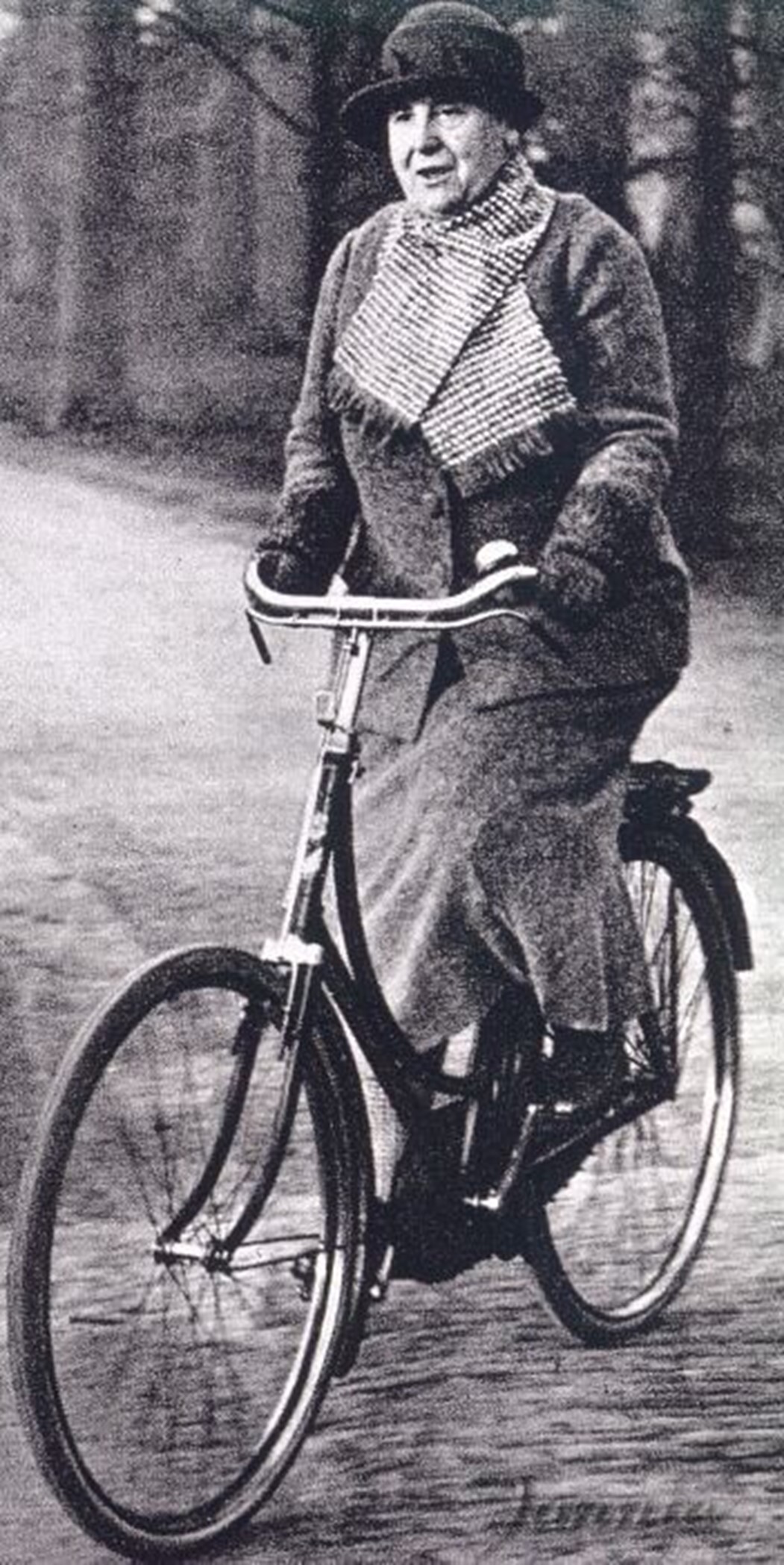Jos Rietveld collects bicycles of the brand Fongers and wrote the book Fongers, het illustere rijwielmerk. For the Third Floor, he wrote an article on the history of the bicycle and the rise of the Fongers brand.
The Design! exhibition features a 1905 woman’s bicycle by the Fongers company. What seems at first sight like a simple ‘sit-up-and-beg bike’ (or ‘grandma bike’, as we call it in the Netherlands) turns out on closer inspection to capture the technical development of the bicycle in the early 1900s.
How did bikes actually evolve, where did the Netherlands fit in around 1900, and what role did Fongers of Groningen play?
Invention of the bicycle
Contrary to what we like to think in this country, the bike was not a Dutch invention. The first, basic models appeared in the nineteenth century in Germany, France and Britain.
The Laufmaschine or ‘running machine’, also known as the draisine, was invented in Germany in 1817 by Freiherr Karl von Drais. It had a simple wooden frame and two wooden wheels with a seat in the middle for the rider, who propelled it with his legs. This rudimentary bicycle did not yet have pedals, but it did have movable handlebars. If the rider built up enough momentum, he could lift up his legs and freewheel.


Around 1863, the French inventor Pierre Michaux unveiled his vélocipède, a wooden bicycle with pedals fixed to the front wheel, which enabled the rider to set off and keep the bike in motion without touching the ground. Like the draisine, the wood and iron design did not make for a comfortable ride: the cyclist felt every single bump in the road. Hence the ‘boneshaker’ nickname earned by this early bike.
In 1870, James Starley in England took the vélocipède to the next stage. His high-wheelers were distinctive bicycles with a large front wheel and a smaller rear one, better known later as penny-farthings. The model was still driven by pedals fixed to the front wheel, with the rider now sitting more or less directly above it. The larger front wheel meant that with each revolution a greater distance could be covered and a higher speed achieved.

A lever was added to the handlebars, meanwhile, so that a simple brake could be applied to the front wheel. The back wheel was small, since it served purely as a support for the one at the front (around which everything literally revolved). These bikes were far from easy to mount and riding them could be pretty hazardous: applying the brake or obstacles on the road could send you flying over the handlebars. That’s why photographs from the period 1870–85 mostly show them being ridden by fit young men. All the same, they gave a significant boost to cycling. Penny-farthings were bought by youngsters from well-to-do families and races were organized for them too. Jaap Eden, Marten Kingma and Pim Kiderlen, who often competed in skating contests in the winter, pioneered such events in the Netherlands.

In 1885, an Englishman called John Kemp Starley came up with an entirely new design, the safety bicycle, which had a set of pedals that drove the rear wheel via a chain. The new model had roughly equal-sized wheels and a saddle in the middle of the frame so that the cyclist’s legs were positioned above the chainwheel, making it much easier to ride than a penny-farthing.
It was a lot safer too, hence the name (its Dutch name – veiligheidswieler – likewise references the safety aspect). Early examples still had thin, solid tyres, but when John Boyd Dunlop developed a pneumatic version in 1888, virtually all safety bicycles were fitted with these much more comfortable tyres from around 1890 onwards. The safety was also more suitable for women, who sometimes swapped their long skirts for knickerbockers. Bicycle ownership now began to increase rapidly among the well-off European middle classes.
By around 1895, the safety bicycle had basically reached the peak of its development: the men’s model had a diamond-shaped frame (see photo on the right: Fongers men’s safety bicycle, 1894) and the women’s model a bent-tube frame. All sorts of variations on these shapes were tried out in the years that followed, but the basic design did not change significantly. Wheels, handlebars, chains and saddles were all improved over the ensuing decades, but always as incremental variations on the basic set-up already being used in 1895.

In its current form, therefore, the bicycle has been around for the best part of 130 years. It has proved an extremely future-proof invention, which has found its way around the world.
Cycling in the Netherlands
Bicycles in the late nineteenth century were mostly produced in Britain, Germany, France and America – countries where the industrial revolution was already in full swing by mid-century. The British bicycle industry flourished especially strongly between 1880 and 1900. Around that latter year, the majority of bikes sold in the Netherlands came from Britain and, to a lesser extent, from America and Germany. Dutch cycle production still amounted to very little at that point. The first bicycle factory in this country was Burgers in Deventer, which opened in 1869. Names like Simplex (Utrecht) and Fongers (Groningen) made their tentative appearance in the mid-1880s, but as yet their workshops turned out only a few bicycles each year. It was hard for Dutch companies to compete with the big, specialized factories in Britain and America, not least because people here had little faith in locally manufactured goods. Sales in the Netherlands were still low around 1895, partly because a bicycle remained expensive: a price tag of 250 to 300 guilders was more than the average worker earned in a year.
The success of the first bicycle exhibition at the Paleis voor Volksvlijt in Amsterdam in 1895 prompted several entrepreneurs to build large factories more or less simultaneously the following year: Simplex in Amsterdam, Gruno in Winschoten, Burgers in Deventer and Fongers in Groningen. Early output did not run to more than 2,000 bicycles per factory, whereas some 150,000 bicycles were already in use in the Netherlands by 1900 (we know this from records of the bicycle tax introduced in 1899). Dutch manufacturers are estimated to have supplied no more than 5% of bicycles sold in the country in 1900. Bikes were still a luxury item at the turn of the century, affordable only by the better-off.
It was not until the First World War that domestic bicycle production first began to outstrip imports. Raw material shortages between 1914 and 1918 meant that many foreign factories were no longer able to meet demand, significantly boosting the industry in the neutral Netherlands. Dutch purchasing power also began to increase year-on-year after 1920, which stimulated demand for bicycles. A wider supply (several dozen Dutch factories and workshops were operating by 1925) drove down prices, bringing bikes within reach of many more people. By the 1930s (with prices continuing to fall until 1935), the bicycle had become the most popular mode of transport in the Netherlands. In 1935, a population of 10 million owned around 4 million bikes, at a time when motorcycles and cars had barely begun their advance.
Unlike neighbouring countries, however, the Dutch continued to cycle, including those who could afford motorized transport. Ever since then, the Netherlands has been the quintessential cycling nation. A key factor behind this success was the laying of dedicated cycle paths from as early as 1920, which means that Dutch urban planning has been promoting cycling for almost 100 years now. This only began relatively recently in other countries, with the result that cycling is much less established than it is here, even in flat countries and regions.
The bicycle continued to play an important role as an everyday means of transport for many Dutch people after the Second World War. Sales levelled off in the late 1950s, however, with the advent of the moped, followed in the early 1960s by the strong rise of the passenger car. An increased focus on health and exercise in the 1970s then increased the popularity of racing and touring bikes. Around 1 million new bikes have been sold annually ever since. The invention of the electric bike means that new cycles are increasingly being supplied with this assistive technology (two thirds of all cycle sales in 2022). The e-bike has thus ushered in a further new phase in cycling in the Netherlands.
Fongers
The blacksmith Albert Fongers began to make bicycles (high-wheelers at first and later safety bicycles) in Groningen city centre in 1885. Eight years later, he built his first small factory next-door to his smithy, turning out around 200 safety bikes a year. Fongers set up a limited company in 1896 and used the capital he raised to build a large factory on Hereweg, the main road leading into the city. He produced luxury touring bicycles there after the English example. Fongers bikes (which cost roughly 175 guilders around 1900) appealed to well-to-do customers. He went on to open eight branches across the country, where they could order custom models. The Dutch royal family too began to ride Fongers bicycles in the 1920s (see photo: Queen Wilhelmina on a Fongers bike, c. 1929). The company focused on the upmarket segment.

Business fell off after the Second World War, as demand for classic deluxe touring bicycles declined and Fongers failed to respond quickly enough to the growing market for cheaper, modern bikes. The company eventually folded in 1970.
The bicycle displayed in the Design! exhibition is a luxury ladies’ model from 1905, equipped with an eccentric bottom bracket. The chain is tensioned by turning the bushing in which the bottom bracket rotates forwards or backwards and then fixing it. This system means that no chain tensioners are required and the back of the frame has a closed construction.
The current owner found the badly neglected bike in 2020 in a shed in Harlingen. He has since restored it as faithfully as possible to its original condition.


